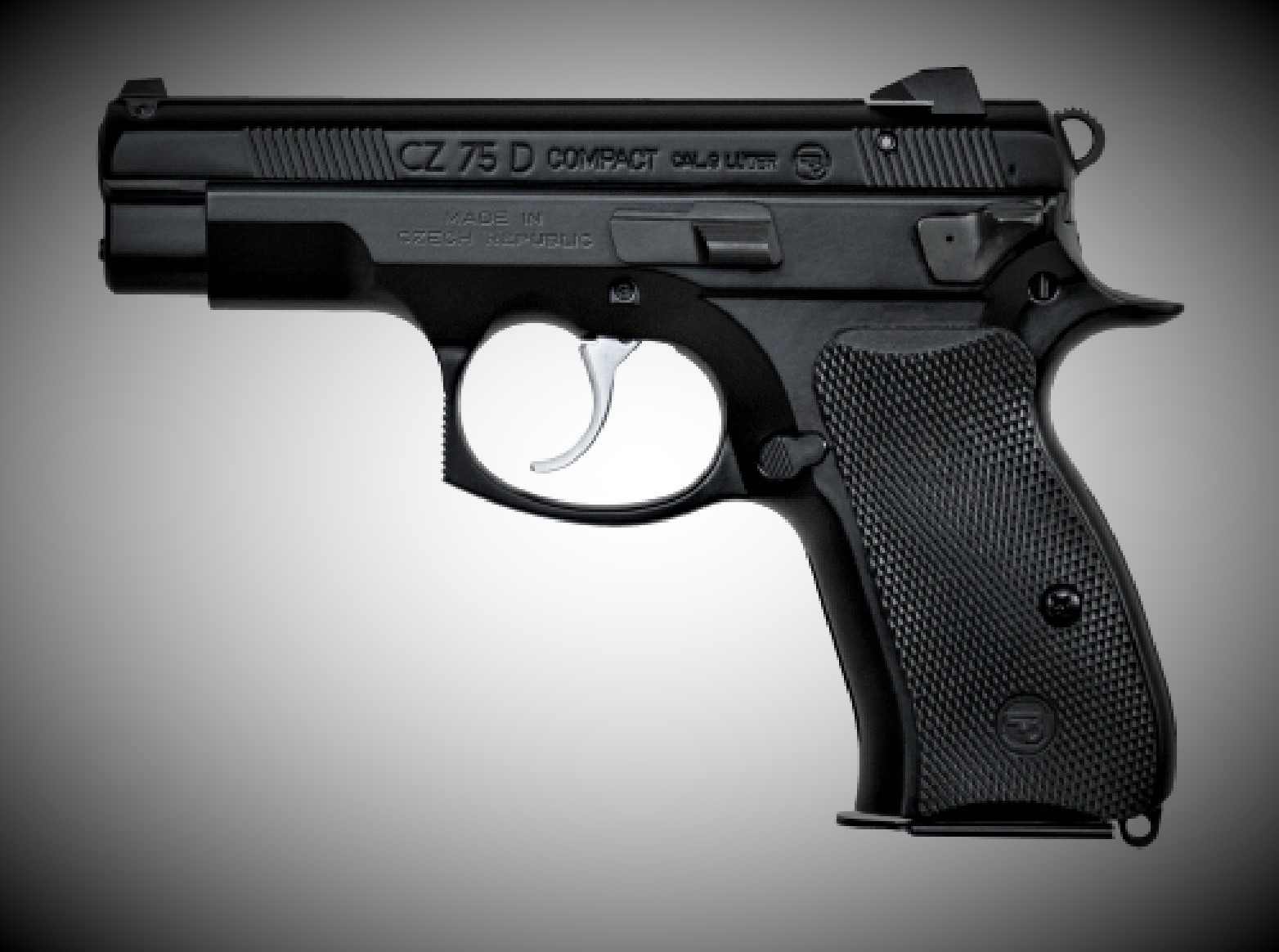
“The PCR name stands for ‘Police Czech Republic,’ the group for whom the model was originally designed. Identical in size to the CZ 75 Compact, it weighs in at a full 1/4 pound lighter owing to its forged aluminum frame, making it more comfortable for everyday carry. Remarkably like the P-01, the PCR uses the same alloy frame minus the light rail, making it even more concealable.
Equipped with a de-cocking lever, the PCR is designed to be de-cocked before holstering. After de-cocking, the trigger pull is much like that of a double action revolver. While there is no need to flip a safety lever off, the longer and heavier trigger pull for the first round requires the conscious decision to pull the trigger before firing. Other additions to the PCR include rubber grip panels, serrated front and back straps for improved handling and a loaded chamber indicator.” – Source: CZ USA
Product Information
| Product Name | CZ 75 PCR – 9mm |
| SKU | 91194 |
| Firearm Type | Handgun |
| Purpose | Concealed Carry |
| MSRP | $617.00 |
| Chambering | 9mm Luger |
| Magazine Capacity | 15+1 |
| Magazine Type | Double Stack, steel |
| Number of Magazines | 2 |
| Frame | Aluminum (7075 T6) |
| Grips | Rubber |
| Trigger | Mech DA/SA |
| Trigger Pull Weight | |
| Double Action (5 pull average) | 11 pounds 11.6 ounces |
| Single Action (5 pull average) | 5 pounds 14.7 ounces |
| Sights | Snag-Free Fixed 3-Dot luminescent |
| Barrel | Cold Hammer Forged |
| Barrel | Length 3.75 in |
| Weight | |
| Unloaded with magazine | 1 pound 11.3 ounces |
| Loaded (15+1 rounds of 147-grain FMJ) | 2 pounds 2.8 ounces |
| Overall Length | 7.24 in |
| Height | 5.03 in |
| Width | 1.38 in |
| Safety | De-cocking Lever, Safety Stop on Hammer, Firing Pin Block Safety, Loaded Chamber Indicator |
So, here I am with a CZ 75 BD, a full-size, all-metal, and heavy pistol, which was my carry following the Beretta M9. Next followed a CZ 75 Compact, a smaller but still an all steel pistol that can weigh at the hip after several hours of carry. The CZ 75 BD, fully loaded, weighs 2 lbs. 11.5 oz. (with 16+1 147-grain JHP). By comparison, the CZ 75 Compact’s loaded weight is 2 lbs. 7.9 oz./44.8 oz. (loaded 14+1, 147-grain JHP). Could there be an answer to the weight issue without going smaller with lesser ammunition? Yes, yes there is. There just happens to be a VZ pistol that is compact and lightweight (compared to the ones mentioned), that weighs in at 2 pounds 2.8 ounces loaded with 15+1 rounds of 147-grain JHP 9mm ammunition, and I am going to tell you about it.
The CZ line of pistols brings you everything that you look for in a pistol; forward styling, reliability, and high capacity. I prefer wood and steel and CZ continues to deliver what I prefer. I have become an ardent fan of CZ firearms, and especially the CZ line of pistols, ever since my first purchase of a CZ 75B Omega model. Subsequent models followed to include the CZ 75 BD and CZ 75 Compact. With two full size and one compact 9mm CZ pistol in the collection, it was time for a lightweight compact to round things out to an even number. The CZ 75-D PCR was the logical choice.
Everything about the CZ 75-D PCR is exactly right. From the rubber grip panels to the front sight, there is really nothing on this pistol that I want to change, and that is saying something since I do like wood grips on pistols that can bear them. However, I do have the option of changing grip panels should I so desire at some later time (see Updates). The front strap and rear strap have vertical serrations to aid in gripping the pistol.
The CZ 75-D PCR is comparable in size to the Glock G19 and the CZ P-01 (and others) and it has a 15-round capacity. The CZ 75-D PCR is very compact, with an aluminum alloy frame but lacks the M3 rail frame of the CZ P-01 and features a smaller muzzle point and snag free 3-dot luminescent sights. I am not a fan of rails and the CZ 75-D fits that requirement. The CZ 75-D PCR is a popular choice for a carry weapon, known for its inherent accuracy and weight distribution. The fit in the hand is near perfect with the grip angle and styling of the grip panels, which do provide an excellent gripping surface.
As you may know, the CZ 75 has been around for a long time, since 1975, in fact. As such, it would be considered old school by modern pistol standards where striker-fired pistol is the norm. Old dogs like me simply like wood, steel, and hammers and the CZ 75-D PCR has all three. Additionally, we like a handgun to have style, but more importantly it must be reliable and accurate. Again, CZ comes through. The CZ 75-D PCR has been the workhorse of European law enforcement and military and was the reason for the CZ 75-D PCR’s existence.
The CZ 75-D PCR is a de-cocker only model, which means that there is no safety, although the de-cocker could be considered as one. The CZ 75-D PCR cannot be carried in Condition 1 (otherwise known as “Cocked and Locked”) but is carried in a modified Condition 2 (a round chambered and hammer lowered to a quarter cock position after de-cocking, in this case). The first shot happens after a long double-action pull; whereas, subsequent shots are in single-action mode.
Like other CZ pistols, the slide rides within the frame, which lends to a smaller profile and excellent accuracy, as the rails are full-length. An excellent beavertail prevents the hand from hammer bite and allows a full, high grip on the firearm.
The controls, de-cocker and slide lock, are large and in charge. The de-cocker lever has two positions, fire (up) and a spring loaded de-cock position. The up position of the de-cocker is the default position. As large as the controls are, they are well blended into the overall look of the pistols.
The de-cocking lever is both a bane and a blessing. The blessing is that the de-cocking lever works extremely well. With the hammer cocked, simply push the de-cocking lever down and slightly forward. The hammer falls forward to a safety notch (quarter cock) and the pistol is now in double action mode. Release the de-cocking lever and it returns to its original position. The bane is that the de-cocking lever is at the very rear of the pistol and may cause some to shift their grip on the pistol to engage the de-cocker. However, and although I have somewhat large hands, I can simply raise my thumb up to the lever and engage it with no issues. Personally, I prefer the de-cocking lever on the Sig Sauer line of pistols, where the de-cocking lever is more forward on the pistol, but the one on the CZ 75-D PCR works simply fine, thank you.
Once the pistol is de-cocked” the pistol is in “DA” or double-action mode. In this condition, it takes 11 pounds and 14.6 ounces of trigger pull to drop the hammer. Once the pistol cycles, a 6 pound 11.2 ounce trigger pull drops the hammer. Trigger pull is smooth throughout its travel in double-action or single-action modes.
As an alternative to the de-cocker, and I have used this method not only on 1911 pistols but Beretta and other CZ pistols; point the pistol in a safe direction, place the thumb and forefinger of the support hand around the hammer, and while supporting the hammer pull and release the trigger and then softly ease the hammer forward until it rest against the safety notch (sometimes referred to as the “quarter cock” position). Completely holding the trigger while lowering the hammer places the hammer against the firing pin. While you can use this method, the preferred method is to use the de-cocker.
When de-cocked, the CZ 75-D PCR acts like a double action revolver and is very safe to carry. Some consider the long and heavy double-action trigger pull as a detriment. I; however, do not. Most of those folks have never fired a revolver and have no or little experience drawing a revolver from a holster and firing it. Old school guys like me who have carried a revolver as a civilian and LEO can quickly adapt over someone who only grew up with polymer striker-fired pistols.
The CZ 75D PCR has a chamber loaded indicator on top of the slide.
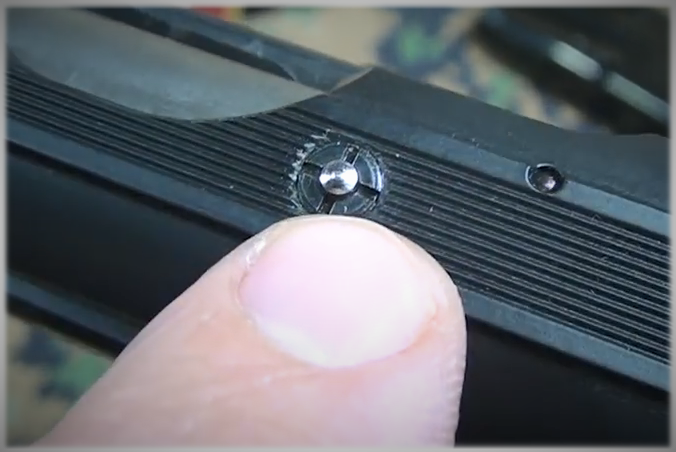
Loaded Chamber Indicator
If I Had a Hammer
Yes, the CZ 75-D PCR is a hammer fired pistol. I prefer a hammer over a striker-fired pistol because I can see the hammer. Of course, the Springfield XDm has a cocked indicator, but it is just not the same to these “old school” eyes. Now, Springfield Armory did hear my thinking aloud about a hammer fired pistol and produced the XD-E series. The XD-E can be carried “cocked and locked” with the safety on, or with the hammer down and the safety on or off. The fully ambidextrous, dual manual safety and de-cocking system allows the user to safely lower the hammer without pulling the trigger. Still, the XD-E is a polymer pistol and not a preference of mine. As I get older, I find myself returning to my ‘old school’ roots.
Prepping for Shooting
Any pistol, especially when new and out of the box, should undergo a thorough inspection, cleaning, and lubricating prior to shooting for the first time. The CZ 75-D PCR is no different from other pistols in that respect.
Disassemble the CZ 75-D PCR in the same manner as the standard CZ 75, which is a bit different from what you may be used to with other pistols.
- Remove the magazine from the pistol and ensure that the pistol is unloaded. Then, visually inspect to ensure that the pistol is safe.
- Place the hammer in the quarter-cock position.
- Push the slide to the rear until the two rear alignment marks on the slide and frame align.
- KEEPING THE LINES ALIGNED, push (tap) the slide stop from the right-hand side of the frame (i.e. using the magazine base or other non-marring tool).
- Remove the slide stop from the left side of the frame. The slide is still under spring tension at this point.
- Pull the slide and the barrel forward off the frame.
- Remove the recoil spring and guide and finally the barrel. No further disassembly is needed for routine maintenance.

Align the Slide and Frame Marks
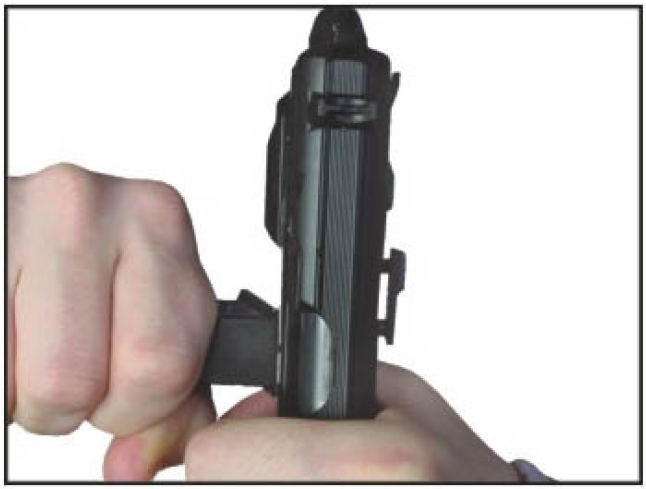
Push the Slide Lock out from the Frame and Then Remove from Left Side of Frame
I am assuming that you have cleaned pistols before, so I am not going to go through cleaning and lubricating methods with you, as you no doubt have a method of your own. If you are unsure as to how to thoroughly clean a CZ 75 series pistol, then watching this video, or this video, may help you.
To assemble the pistol:
- Insert the barrel into the frame.
- Insert the guide rod and recoil spring into the frame and secure it against the barrel.
- Slide the entire assembly onto the frame.
- At a point about midway into the frame, partially insert the pin of the Slide Stop. The pin should be engaged with the barrel’s link-less cam at this point.
- Continue to slide the slide onto the frame, under spring tension from the recoil spring, until the alignment marks on the slide and frame align.
- Align the Slide Stop with the assembly notch in the frame and press inward. An audible click will be heard when the Slide Stop assembly is fully engaged with the frame.
- Perform a function check.
At the Range
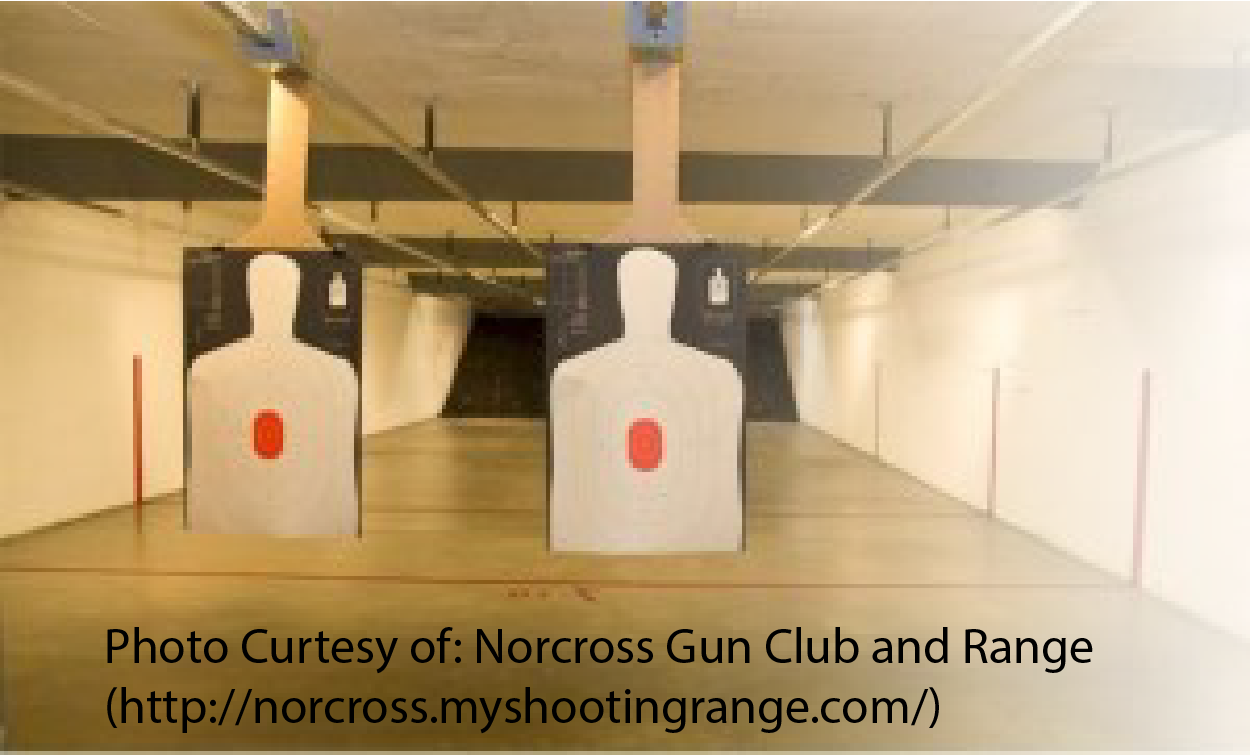
Finding myself, once again, at my usual B&S (Breakfast and Shooting) morning my friend and shooting partner partake of some luxurious dining at a local Waffle House, and then we make the trek to our gun club and range (see info in image above).
This morning I am putting the CZ 75-D PCR through its paces with both practice and defense ammunition. Some Georgia Arms 124-grain FMJ leads the way for function testing and a bit of an accuracy check. Sig Sauer V-Crown 124-grain JHP is served up for defense ammunition cycling and I thought that I would throw in a few Sig Sauer V-Crown 147-grain for added measure.
The exceptionally smooth double-action trigger pull is about 11 pounds 11.6 ounces (5-pull average), and there is a ‘trick’ to get that weight to work for you. The ‘trick’ begins at the high-ready position with the barrel facing to the target. As the arms begin extending to the final shooting position, begin pulling the trigger. The object is that when the arms are extended to the final shooting position, the trigger pull is about completed and there is just a short distance to go before the hammer drops. This is the point where the sights are in final alignment with the desired point of aim. The entire process is to be one smooth trigger pull without interruption. This is easy to say and harder to achieve, as it takes coordination and timing to pull off (no pun intended).
There is, what seems, a long bit of free play before take-up begins. The stroke; however, is shorter than I expected.
The double-action trigger pull is very reminiscent of a good, smooth double-action revolver with a short stroke. There is no “staging” point when in double-action mode, but one can be dictated by your trigger finger, or I should say, the position of the trigger finger during the pull stroke. With practice, you can sense the position of the trigger before the break. This is a useful feature for target shooters who are not under a time constraint. In defensive mode, and with normal trigger operation, the “staging point’ is easily passed, but is still present if looked for.
Trigger reset is quick and clean. In single action mode there is, surprisingly, a shorter take-up than I expected. The wall is slightly ‘mushy’ but the trigger breaks clean and crisp. The single-action trigger pull is 5 pounds 14.7 ounces.
There are, actually, two double-action hammer positions. The first is with the hammer all the way forward and resting against the firing pin. No need to worry; however, since the firing pin block prevent the hammer from impacting the firing pin unless the trigger is pulled. The trigger travel is long but smooth throughout the pull. The second position is in the quarter cock position, which is the position that the hammer resides in after de-cocking. The total travel is the same as before, but there is more trigger free play before tension is reached. The tension stroke; however, is much shorter. Either hammer position is safe for carry, as the hammer block prevents the firing pin from moving forward unless the trigger is pulled.
The de-cocking lever works very well and has a positive click when going into the de-cock position. The operation is a bit foreign to me, however. The de-cocking lever is pushed down at the rear of the lever and is not what you would expect if you are used to pushing down on the front of a lever, for example a Beretta or 1911 pistol. On the CZ 75-D PCR, simply push down and then forward on the de-cocker lever. When new, the de-cocking lever takes some force to engage. In my hand, my thumb is at the first joint when engaging the de-cocker. That might bother some people, but once practiced the motion will come automatically.
The extractor is external, and the ejector is internal. Both do their jobs well.
The provided two magazines have polymer base plates and functioned flawlessly. In my hand, that base plate provides my little finger a place to rest and I will purchase additional magazines for the CZ 75-D PCR Compact at first opportunity.
The CZ 75-D PCR, as normal, ran without flaw, barring the magazine release issue.
Once I figured out my POA and POI, some “Mozambique” drills ensued. Beginning the three-round string from a de-cocked pistol at seven yards resulted in all rounds impacting close to where I wanted them. I did not have to respond to that long double-action pull as I thought I would, due to the shorter trigger stroke than most double-action/single-action pistols. Moving out to 10 yards resulted in the same. Any inaccuracies were the fault of the shooter and not the pistol.
Although the frame of the CZ-D PCR is alloy, the felt recoil is not that much different from the CZ Compact with its steel frame. Felt recoil from the 9mm is little in the first place. The rubber grips of the CZ 75-D PCR helps to soak up some of the recoil, and the grip contour aids in control.
I wish that I could report an issue with the pistol, because as a reviewer of firearms there is always something to nag about, so here is one. The magazine release button, although extended, takes some force to press inward. And one would think that after that concentrated effort one would be pleased with the magazines falling free from the magazine well. Well, one would be disappointed, as the magazines do not fall free (at least the magazines provide with the pistol) but must be stripped from the magazine well. I have read about this in other reviews and I am looking for a fix – if any. With that said, I inserted other CZ (and Mec-Gar) magazines that I have, and most fell free without issue, especially the Mec-Gar. That tells me that it is a magazine width issue with the provided magazines and some experimentation will ensue. Like apples on a tree, magazine must fall free. Oh my, I made a rhyme!
Concealment
This is the point in my reviews where I tell you that the firearm under review can be concealed. So, I will; “The CZ 75 Compact can be concealed.”
Any holster that the full-size CZ 75 can fit into will also house the CZ 75 Compact. I can say; however, that my CZ 75 Compact will never feel Kydex on its surface.
As with any concealed carry, doing so requires planning, the right gear, the right dress, and the right attitude.
One leather holster option from Simply Rugged Holsters is the “Cumberland” holster. I have this holster for several of my pistols to include any 1911, the Glock G41 and G34, the Beretta 92/M9, and one has been ordered for the CZ 75 (which includes the CZ 75 B Omega, the CZ 75 BD, and the CZ 75 Compact, and now the CZ 75-D PCR).
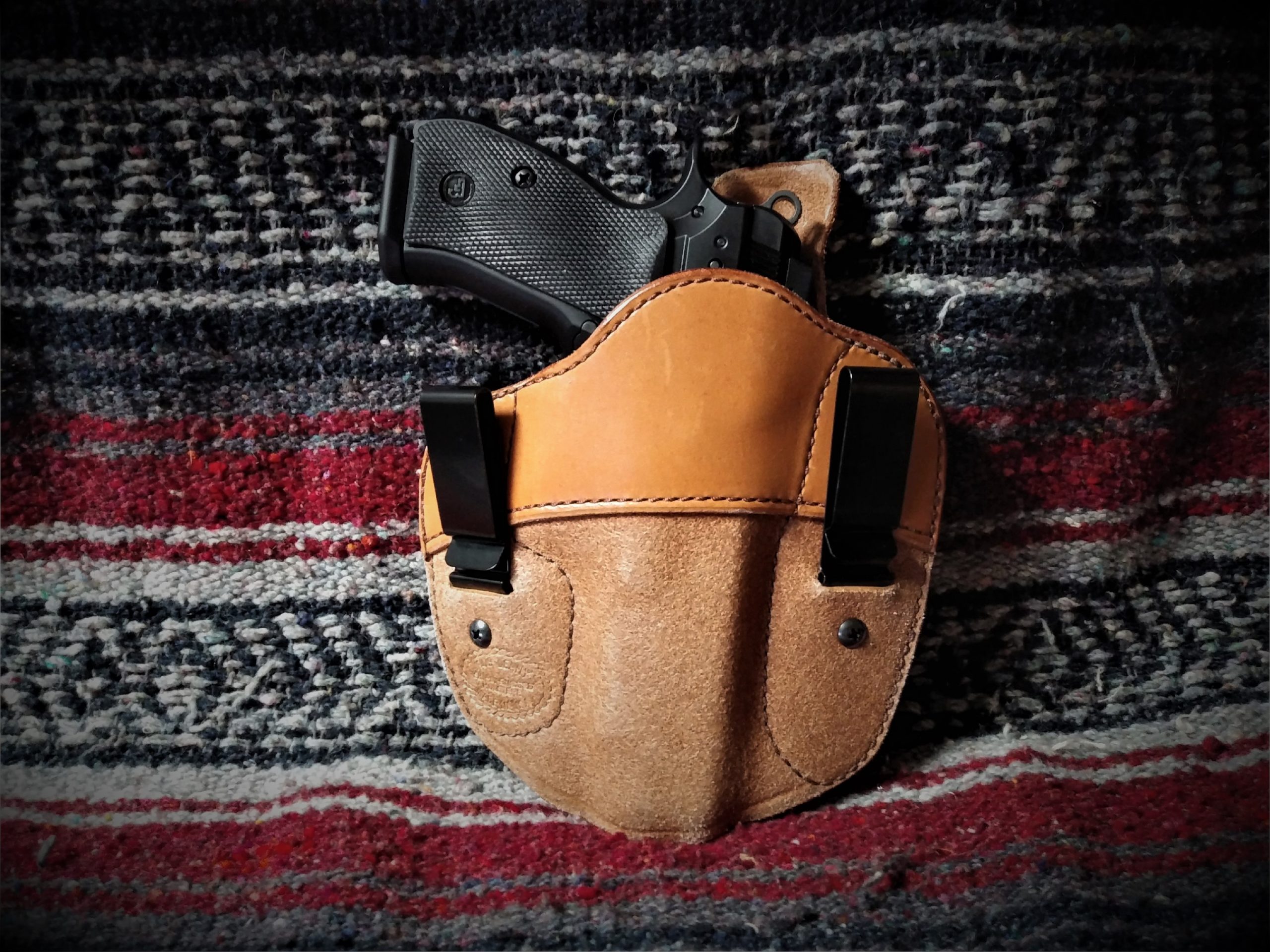
Simply Rugged “Cumberland” Holster (CZ 75 PCR Shown)
Two holsters, which I like, that are designed to fit the CZ75B; the Falco A112 Hawk and the Craft Shoulder Holster System with Mag Pouch (Code: It. OK1). The Galco Miami Vice and Miami Vice II shoulder holster systems; albeit more expensive than the Craft system, are also excellent choices.

Falco A112 Hawk IWB Holster (CZ 75 Compact Shown)
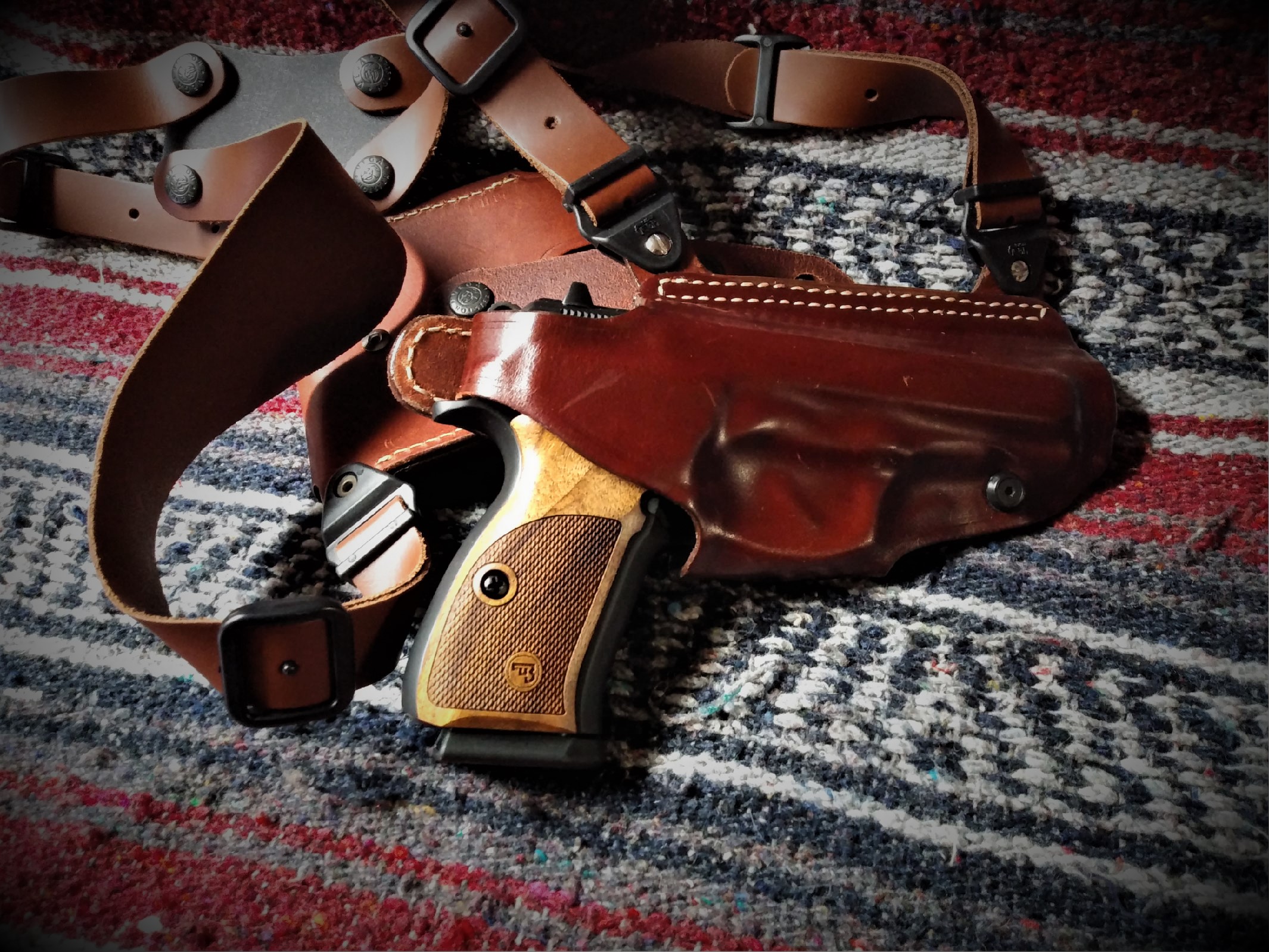
Craft Shoulder Holster System (OK1) with Mag Pouch with CZ 75 Compact Shown
Another holster is the “Cuda” from Simply Rugged, shown below. This holster can be used OWB or IWB (straps can be purchased for IWB carry).
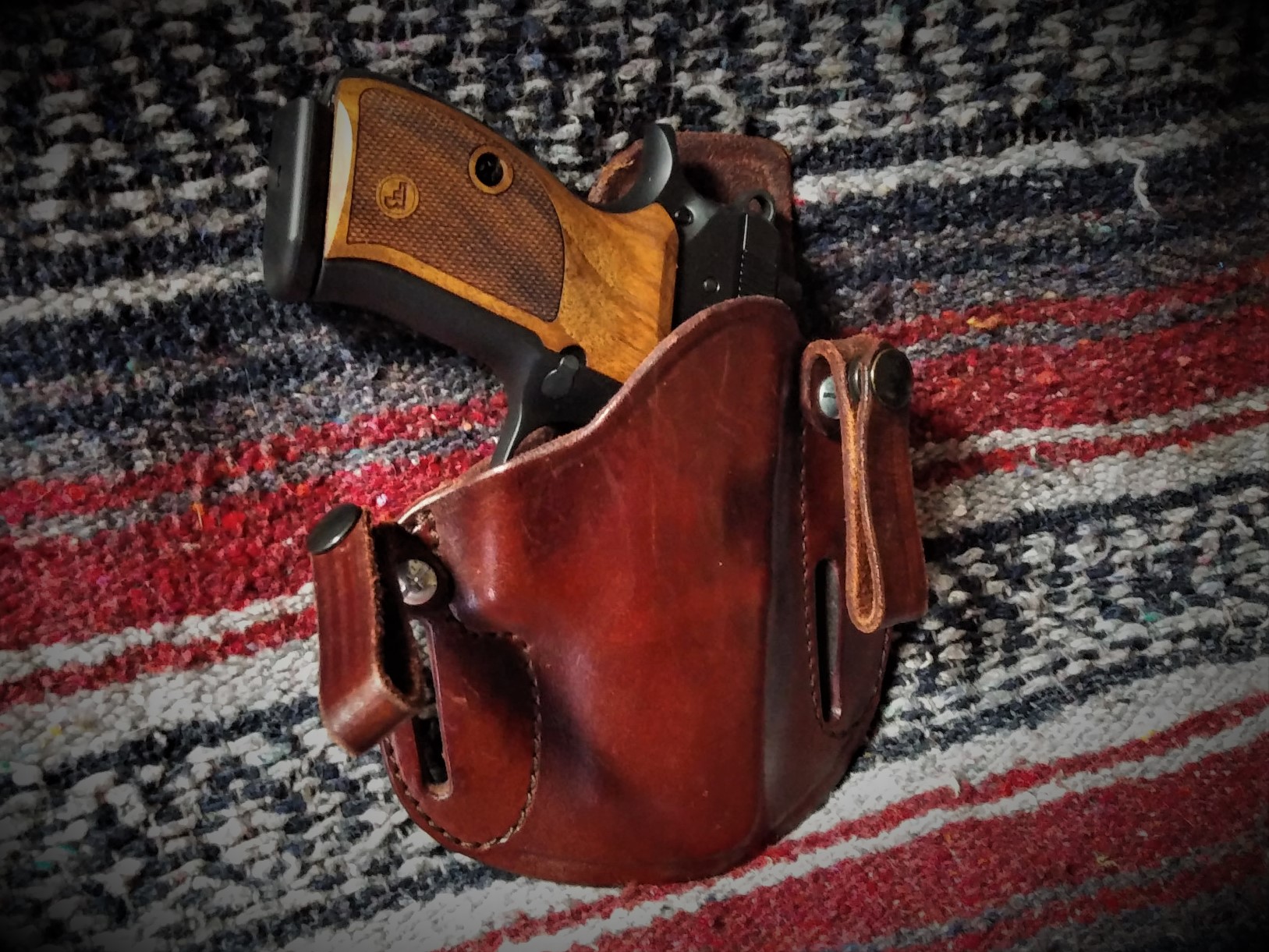
“Cuda” Holster from Simply Rugged Holsters with CZ Compact
Some Precautions are in Order
I keep A-Zoom Snap Caps around for every caliber of firearm that I have, including rifles and shotguns. I have become accustomed to having a snap cap in any firearm that I intend to dry fire. The CZ 75 series of pistols is no exception.
It has been stated in several articles that the firing pin block roll pin can become damaged when dry firing a CZ 75 without a snap cap or dummy round in the chamber. The Springfield Armory XD series suffers from the same malady. I also use snap caps in any single-action and double-action revolvers just to protect firing pins.
Updates
I have to say that, for me, I struggled with upgrading the pistol. Sure, the luminescent sights could be exchanged with night sights, and the grip panels exchanged for a set of G10 or even wood (the latter being my preference). The sights are adequate, and I have sure used worse. I will say that the provided rubber grips are genuinely nice and really provide a fine gripping surface. Some have complained that when carrying the pistol, the rubber grips will catch on the clothing and cause printing. However, I carried the CZ 75D PCR for a week and found that did not happen, at least for me, but I did succumb to my wood panel preference and a set of CZ wood grip panels now adorn the pistol.
Wrapping it Up
The CZ 75, in any form, is a pleasing pistol to look at. CZ has coated the pistol in what they call black poly coat. That does not mean that the pistol is shiny – it is not, which is fine with me, because shiny pistols are harder to conceal. I wear a black T-shirt as part of my casual dress, and a black pistol and holster makes a good concealment option.
So, the question if I would carry the CZ 75-D PCR is still out there. The answer is a resounding yes. In fact, it is one of the few pistols that I enjoy carrying. The weight tells me that I am carrying something substantial and that gives me some confidence in the firearm that I am carrying should I need to need it when the elephant arrives.
If you are in with the polymer ‘wonder nine’ crowd, you owe it to yourself to become familiar with the ‘old world’ products that are just as relevant today as they were in their heyday, and who’s to say that their day is over? It will also make you a more well-rounded shooter.
Once again, I am happy to say testing and evaluating this pistol has been a joy. With the market currently geared towards slim and polymer concealed carry pistols it is easy to overlook something like a CZ 75 variant. During the evaluation period I began to think about my current carry system and the possibility of going to the CZ permanently. While I will not be hanging up the 1911 any time soon, I think the CZ 75-D PCR has earned a longer stay, as has the Beretta M9 and my other CZ pistols. I am certain this gun will be revisited for a follow up review. Opinions sometimes change regarding carry pistols. I know mine have, out of necessity. But I can say with confidence, that the CZ 75-D PCR is one hell of a compact pistol, it would make a great summer carry, and that is all I have to say.
Resources
I am happy not only to share my opinions, but also the opinion of others, as they may also have an influence on your decision to invest, or not, in this pistol. So, here is some reading and viewing material.
- Glock19 and CZ 75D PCR Compact Comparison: https://www.youtube.com/watch?v=vcmwAtUkeQo
- CZ -75 Compact PCR 9mm Pistol: https://www.youtube.com/watch?time_continue=580&v=kDx3BtSHLwg&feature=emb_logo
- CZ 75D PCR and CZ 75 P-01 Comparison: https://www.youtube.com/watch?v=eeoTQkLctM4
- CZ 75 D Compact PCR Aluminum Framed Awesome!: https://www.youtube.com/watch?v=7tClu5_Vjr8
- CZ 75 D Compact PCR Review: https://www.youtube.com/watch?v=mZlEtK-mlH8
- CZ 75 Compact D PCR – Table Top Review and Roll Stamp Mysteries Unveiled: https://www.youtube.com/watch?v=7uEzdw9hpU4
- C7 75 D Compact PCR Full Review: https://www.youtube.com/watch?v=C9dTkzo4VDQ
- CZ PCR Review: https://www.youtube.com/watch?v=MtPUAgho8hk
- CZ 75: https://en.wikipedia.org/wiki/CZ_75
- CZ 75 D Compact PCR Review: https://www.youtube.com/watch?v=rpUpUabWl4s
- C7 75 D Compact PCR Full Review: https://www.youtube.com/watch?v=C9dTkzo4VDQ
- CZ 75 D PCR COMPACT 9MM – SH007ER Reviews: https://www.youtube.com/watch?v=Xn6cyaNXCm0
- CZ 75 9mm Compact PCR. MIDDLEWEIGHT AWESOMENESS: https://www.youtube.com/watch?v=_yk3tpK4auA
- cz pcr: https://www.youtube.com/watch?v=AjClBogBPEk
- CZ 75 D Compact: https://www.youtube.com/watch?v=SbTo-8GAKVQ (Author’s Note: Notice the shooter is using the “Israeli” method of carry.)
- CZ 75D Compact: https://www.youtube.com/watch?v=ieUoinMIAcE
- Glock 19 vs CZ 75D Compact PCR for Concealed Carry: https://www.youtube.com/watch?v=Z_gVd7OMUCU
- Wilson Combat Training Tip: Double-Action Single-Action Transition: https://www.youtube.com/watch?v=ivs-URdfWu4
- Fear Not the Double Action Shot. Part I: https://www.youtube.com/watch?v=FsoX26OhDCY
- Fear Not the Double Action Shot Part 2: https://www.youtube.com/watch?v=GZplH6zreQI
- Fear Not the Double Action Shot Part 3: https://www.youtube.com/watch?v=nod5qLlSGUM
- Learning the Double Action Single Action Trigger: https://www.youtube.com/watch?v=bU4v5i5c42k
![]()

